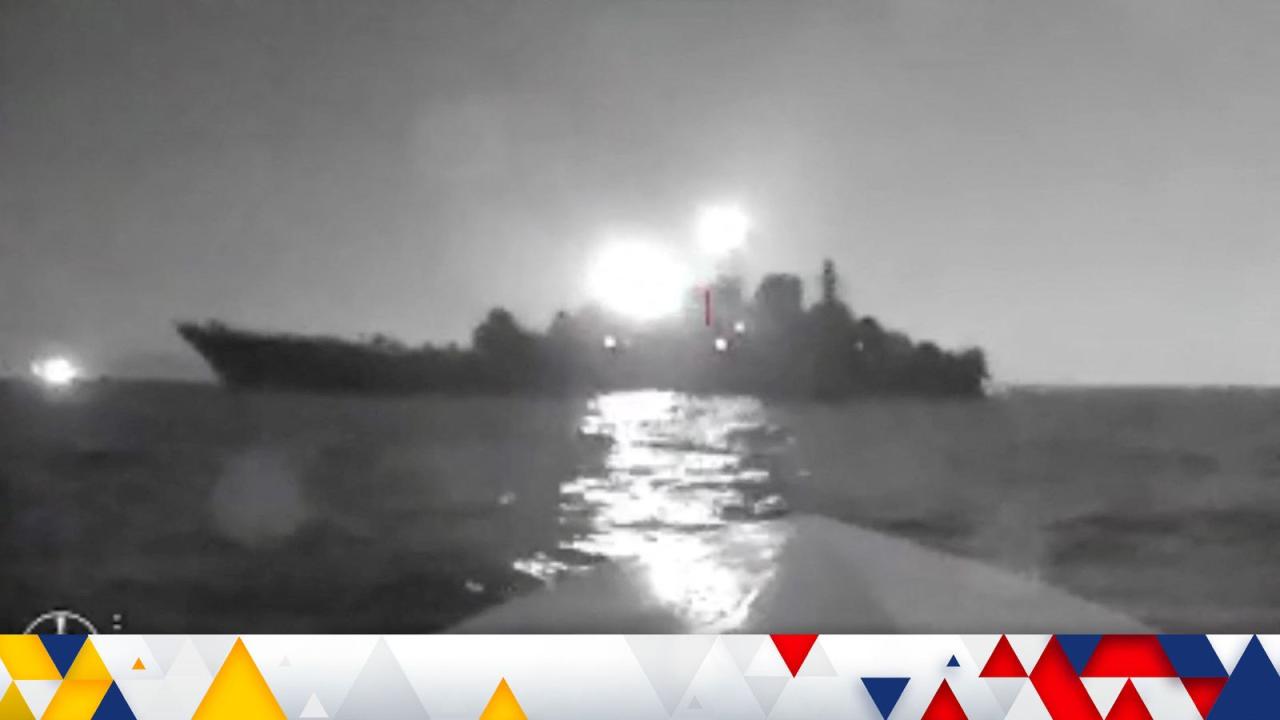Ukrainian sea drones are changing naval warfare. These unmanned vessels, ranging from small, expendable craft to more sophisticated autonomous systems, are proving surprisingly effective against larger, more expensive naval assets. Their deployment represents a significant shift in naval strategy, forcing a reassessment of traditional defense methods and highlighting the growing importance of asymmetric warfare.
This exploration will cover the technical specifications of these drones, their operational capabilities and deployment strategies, their impact on naval warfare, future technological advancements, and the wider geopolitical implications of their use. We’ll examine their design, materials, guidance systems, and effectiveness in real-world combat scenarios, comparing them to similar technologies used by other nations.
Ukrainian Sea Drone Technical Specifications
Understanding the technical specifications of Ukrainian sea drones is crucial to assessing their effectiveness in naval warfare. These unmanned surface vessels (USVs) come in various configurations, each designed for specific missions and operational environments. Their design incorporates a blend of readily available commercial components and bespoke military adaptations, resulting in a surprisingly effective and adaptable weapon system.
Types and Key Features of Ukrainian Sea Drones
While exact details are often kept classified, several types of Ukrainian sea drones have been observed and reported. These range from smaller, expendable units to larger, more sophisticated platforms with increased range and payload capacity. The following table summarizes their key features, though precise specifications remain subject to change and official secrecy.
| Type | Size (approx.) | Payload Capacity (approx.) | Range (approx.) | Speed (approx.) | Propulsion |
|---|---|---|---|---|---|
| Small, Expendable Drone | 1-2 meters | 50-100 kg | 10-20 km | 5-10 knots | Electric Motor |
| Medium-Range Drone | 3-5 meters | 200-500 kg | 50-100 km | 10-15 knots | Electric Motor/Internal Combustion Engine |
| Larger, Multi-Mission Drone | 5-10 meters | 500+ kg | 100+ km | 15+ knots | Hybrid Propulsion |
Materials and Construction

The construction materials used in Ukrainian sea drones likely prioritize affordability and ease of production while balancing durability in harsh marine conditions. Common materials may include fiberglass reinforced polymers (FRP) for their lightweight yet strong properties, and potentially aluminum alloys for structural components. The choice of materials influences factors such as resistance to corrosion, impact resistance, and overall weight, all critical aspects for operational effectiveness and survivability.
Guidance and Navigation Systems
Ukrainian sea drones employ a variety of guidance and navigation systems, ranging from pre-programmed GPS waypoints to more sophisticated systems incorporating inertial navigation units (INUs) and potentially satellite-based augmentation systems (SBAS). Some drones might also utilize image recognition and AI-assisted navigation to enhance their autonomous capabilities and adapt to changing conditions. The specific methods employed are likely tailored to the drone’s mission profile and the level of autonomy desired.
Operational Capabilities and Deployment Strategies: Ukrainian Sea Drone
The successful deployment and operation of Ukrainian sea drones require a well-coordinated effort. Their operational capabilities are significantly enhanced by effective deployment strategies and robust communication systems.
Ukrainian sea drones are proving surprisingly effective in naval warfare. Their innovative designs highlight the growing importance of unmanned systems, a trend you can see firsthand at the cutting edge of drone technology showcased at the shanghai drone show 2025. Expect to see even more advanced drone tech there, possibly influencing future Ukrainian sea drone development.
Deployment and Recovery Procedures

Deployment methods may vary depending on the drone type and mission parameters. Smaller drones could be launched from larger vessels or even from the shore. Larger drones might require more sophisticated launching systems. Recovery could involve a combination of remote control and autonomous return-to-base capabilities, or in some cases, the drones may be expendable.
- Preparation: Check drone systems, load payload, and program mission parameters.
- Launch: Deploy drone from designated launch point using appropriate method.
- Navigation: Drone navigates to target location using pre-programmed route or autonomous navigation.
- Mission Execution: Drone carries out assigned mission (e.g., reconnaissance, attack).
- Return/Recovery: Drone returns to base or is recovered post-mission.
Integration into Broader Military Operations
Ukrainian forces are increasingly integrating sea drones into coordinated attacks, often as part of a broader offensive strategy. This includes using them to distract enemy forces, create diversions, or strike high-value targets in conjunction with other naval assets and land-based units. For example, sea drones might be used to overwhelm enemy defenses before a larger assault, or to target specific ships within a larger fleet.
Communication Systems
Reliable and resilient communication is essential for controlling and monitoring sea drones. Ukrainian forces likely employ encrypted communication links to minimize the risk of jamming and ensure secure command and control. The specifics of these communication systems are likely classified, but it’s plausible they incorporate redundancy and anti-jamming techniques to ensure reliable operation even under hostile conditions.
Effectiveness and Impact on Naval Warfare
The effectiveness of Ukrainian sea drones in naval warfare is evident in their demonstrated ability to inflict damage on Russian naval assets. Their relatively low cost and ease of deployment offer a significant advantage in asymmetric warfare scenarios.
Ukrainian sea drones are making waves, showcasing impressive autonomous capabilities. It’s a far cry from the coordinated spectacle of a massive drone light show, like the amazing china new year’s drone show , but both demonstrate the rapid advancement of drone technology. The precision needed for either application is incredible, highlighting the versatility of unmanned systems. Think of the potential – from military applications to dazzling displays!
Effectiveness Compared to Other Naval Assets
Compared to traditional naval assets like guided missiles or torpedoes, sea drones offer advantages in terms of cost-effectiveness and reduced risk to human personnel. However, they may have limitations in terms of speed, payload capacity, and range compared to more advanced systems.
Strategic Advantages and Disadvantages
The strategic advantages of sea drones include their low cost, ease of deployment, and ability to target high-value assets with minimal risk. However, disadvantages include their vulnerability to detection and countermeasures, and limitations in their range and payload capacity. Their effectiveness is highly dependent on the specific operational environment and the sophistication of enemy defenses.
Impact on Russian Naval Operations
Ukrainian sea drone attacks have demonstrably disrupted Russian naval operations in the Black Sea. While precise figures are often unavailable due to security concerns, reports of damaged or sunk vessels and disrupted logistics operations suggest a significant impact on Russian capabilities. The psychological effect of these attacks is also significant, forcing Russia to dedicate resources to counter these relatively inexpensive threats.
Technological Advancements and Future Development
Ongoing technological advancements will likely lead to significant improvements in the capabilities of Ukrainian sea drones. Increased autonomy, extended range, and enhanced payload capacity are all key areas of potential development.
Future Developments and Upgrades
Future iterations might incorporate improved propulsion systems for greater speed and endurance, more sophisticated AI-based navigation and targeting systems, and enhanced countermeasure capabilities. Increased payload capacity could allow for the deployment of larger warheads or more advanced sensor packages.
Integration of AI and Machine Learning
The integration of AI and machine learning could significantly enhance the autonomy and effectiveness of sea drones. AI-powered systems could improve navigation, target recognition, and decision-making, enabling them to operate more effectively in complex environments and adapt to changing conditions.
Hypothetical Future Model
A hypothetical future model might feature a larger, more robust hull with improved hydrodynamics, a hybrid propulsion system combining electric motors and a small internal combustion engine for extended range, advanced AI-based navigation and targeting, and a modular payload bay allowing for diverse mission configurations. It might also incorporate advanced stealth features and countermeasure systems to improve survivability.
Ukrainian sea drones are proving surprisingly effective, showcasing the potential of smaller, unmanned platforms in naval warfare. Think of the scale though – imagine the dazzling light shows possible with a fleet of them, like what you’d see at the shanghai drone show 2028 , only instead of entertainment, it’s strategic military application. The tech behind these Ukrainian drones is definitely something to keep an eye on; it’s influencing future drone development across the board.
International Implications and Geopolitical Context

The success of Ukrainian sea drones has significant international implications, influencing the global arms trade and naval strategies of various nations. The relatively low cost and effectiveness of these systems make them attractive to smaller nations with limited resources.
Impact on Global Arms Trade and Naval Strategies
The widespread adoption of sea drone technology could lead to a shift in naval power dynamics, particularly benefiting smaller nations that can deploy these relatively inexpensive systems against larger, more technologically advanced adversaries. This could spur a global arms race in the development and deployment of similar technologies.
Comparison with Other Nations’ Approaches, Ukrainian sea drone
While Ukraine has demonstrated the effectiveness of its sea drones, other nations are also actively developing similar technologies. Comparing approaches highlights differing priorities, resource allocation, and technological capabilities. Some nations might focus on larger, more sophisticated drones, while others may prioritize smaller, expendable units for specific missions.
Key Geopolitical Implications
The widespread adoption of sea drone technology could destabilize existing geopolitical balances, particularly in regions with existing naval conflicts. The ease of acquisition and deployment of these systems could lower the threshold for military conflict, making it more accessible to non-state actors and potentially leading to increased regional instability.
Epilogue
The Ukrainian sea drone’s emergence as a potent naval weapon is reshaping maritime conflict. Its relatively low cost, adaptability, and surprising effectiveness against larger targets present a compelling argument for its continued development and wider adoption. The future likely holds even more autonomous and sophisticated versions, pushing the boundaries of naval warfare and potentially influencing global naval strategies for years to come.
Understanding their capabilities is crucial for comprehending the evolving landscape of modern naval power.
Essential FAQs
What are the main targets of Ukrainian sea drones?
Primarily, they target Russian naval vessels, including warships, landing craft, and support ships. They’ve also been used against port infrastructure.
How are Ukrainian sea drones funded?
Funding sources are varied and include government appropriations, international aid, and potentially private donations or investment.
What are the ethical implications of using sea drones in warfare?
This is a complex issue, raising concerns about accountability for civilian casualties and the potential for escalation. International laws of war apply, though their interpretation in the context of autonomous weapons systems is still developing.
What countermeasures are being developed to combat Ukrainian sea drones?
Russia and other nations are likely developing and deploying countermeasures, such as improved anti-drone systems, electronic warfare, and enhanced ship defenses. The exact nature of these measures remains largely classified.
